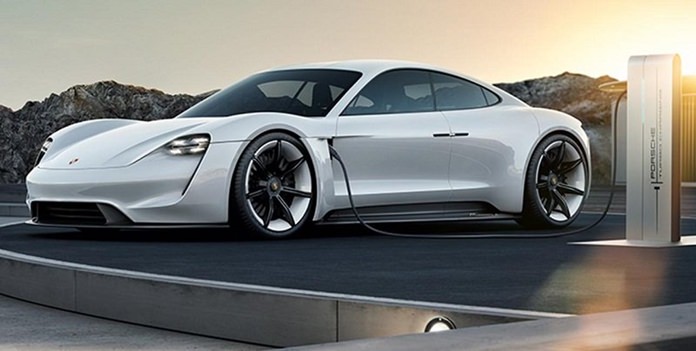
Want to put down your deposit for a Taycan? To go along with the Macan you have already? Or the Tiguan? Or the tincan? Only Nissan can come up with more nonsensical names (bring back the Cedric) though Mitsubishi goes close with the Attrage.
 Porsche has confirmed powertrain details for its first battery-electric vehicle (BEV), which will be officially revealed next year.
Porsche has confirmed powertrain details for its first battery-electric vehicle (BEV), which will be officially revealed next year.
Formerly known as the Mission E in concept guise, the Taycan will employ two permanently-excited synchronous motors (PSMs) – similar to those used in the Le Mans-winning 919 Hybrid racecar – with one driving the front axle, while the other motivates the rear wheels.
Given PSMs are the equivalent of turbochargers, this powertrain combination will deliver a peak power output of more than 440 kW (600 hp).
As a result, Porsche claims the Taycan can sprint from standstill to 100 km/h in “well under” 3.5 seconds while on the way to 200 km/h in less than 12.0s.
Porsche says PSMs were chosen as “they boast both extremely-high sustained performance and maximum efficiency”.
If everything goes as planned the Taycan will have a driving range of more than 500 km, although is its unclear if this figure falls under the incoming, more-realistic WLTP testing cycle or the outgoing NEDC standard.
Tesla claims the Model S can hit triple figures in 2.7s and travel between 360 km and 834 km – depending on driving conditions, speed and other variables – between charges in flagship 568 kW P100D form, which is priced from $248,377 drive away.
Much of the positive factors of the proposed Taycan are due to its 800-volt lithium-ion battery pack, which consists of 400 cells of about 4V each. In line with its sustainability goals, Porsche is already studying how the battery pack can be reused in the future.
Porsche has given the Taycan fast-charging capabilities, which allows it to recoup 400 km of driving range after about a 15-minute charge at an AC charging station with a Combined Charging System (CCS).
A sign of coming times is the cooperation between Porsche, BMW Group, Daimler AG, Volkswagen Group and Ford Motor Company.
This collaboration is creating a fast-charging network for EVs in Europe that will feature about 400 parks with multiple stations each positioned every 100 to 150 km along main traffic arteries by 2020.
All European EV owners will at the same time have access to thousands of brand- and capacity-independent high-power charging stations, which will have a capacity of up to 350 kW per point to enable shorter charging times than the systems currently available.
Alternatively, the Taycan can be charged at an owner’s home via conductive charging using a wallbox or a suitable cable, or inductive charging through a base plate in the floor.
According to Porsche, “three figures worth” of Taycan engineering mules have been built to date, with 40 specialists constructing them at its prototype construction department in Zuffenhausen, Germany.
More than sixty Porsche engineers were recently sent to the western part of South Africa with 21 Taycan prototypes to complete 40,000 km of hot-weather testing.
Taycan engineering mules have also been exposed to cold-weather testing. By the time the BEV enters the European market in late-2019, millions of kilometres of testing will have taken place.
The launch of the Taycan will help Porsche achieve its goal of every second vehicle it sells featuring electrification by 2025, of which BEVs and plug-in hybrids (PHEVs) will have an even split.
As such, sales expectations are high for the Taycan, with Porsche projecting it will sell about 20,000 units a year, or about two-thirds of the 911 sportscar’s current volume.





